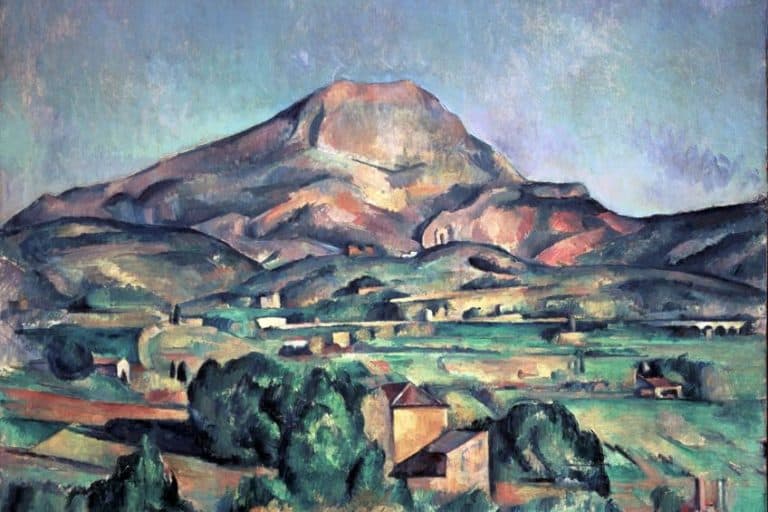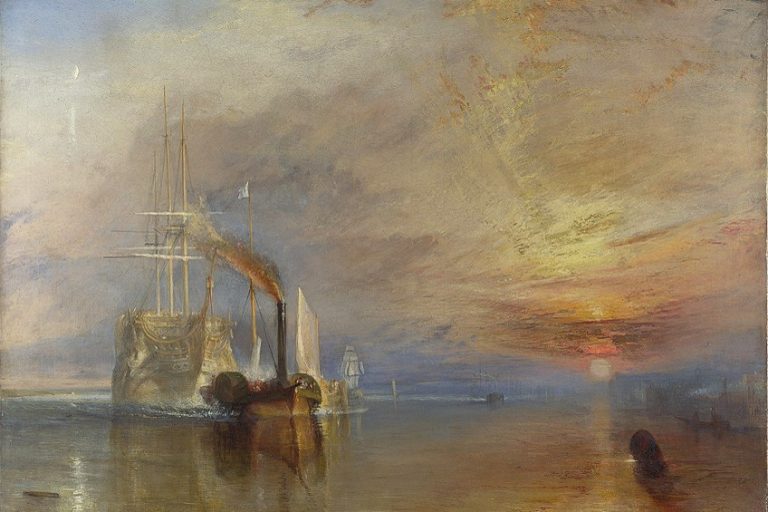“The Creation of Adam” by Michelangelo – An In-Depth Analysis
In the Sistine Chapel, hands are portrayed in various symbolic gestures, with the most famous representation captured in the scene where God reaches out to touch the hand of the first man, Adam. The Creation of Adam by Michelangelo is one of the world’s most famous frescoes that adorns the ceiling of the Vatican City chapel in Rome. The painting has remained a sought-after sight for many tourists, who travel from far and wide to admire the masterpiece. In this article, we will explore this famous fresco, including the symbolism behind it, and the inspiration behind the figures of The Creation of Adam. Keep reading for all you need to know about this Renaissance masterpiece!
The Hand Behind the Fresco: Michelangelo Buonarotti
The creator of the most famous section of the Sistine Chapel ceiling was none other than Michelangelo di Lodovico Buonarotti Simoni, who was perhaps the greatest sculptor, painter, poet, and architect of the Renaissance. Buonarotti was born on March 1475 in Caprese and grew up in Florence. During his teenage years, he apprenticed under many well-known artists, including Domenico Ghirlandaio and Bertoldo di Giovanni. Simply known as Michelangelo, the young artist soon entered the spotlight for his remarkable talents in sculpture, depicting many important narratives from Christianity.
Michelangelo received commissions from several Popes and various wealthy patrons, creating some of the most beautiful sculptures in art history, including “La Pietà” (1498-1499) and “David” (1504), among many others.
Michelangelo also produced architectural designs, one of which was created for the Capitoline Hill in Rome and its renovation. Reportedly, Michelangelo was a Christian believer, who lived frugally, wrote hundreds of poems, and whose talents were comparable to the skills of Leonardo da Vinci. He died in 1564 as one of the greatest and most prestigious artists of his time.
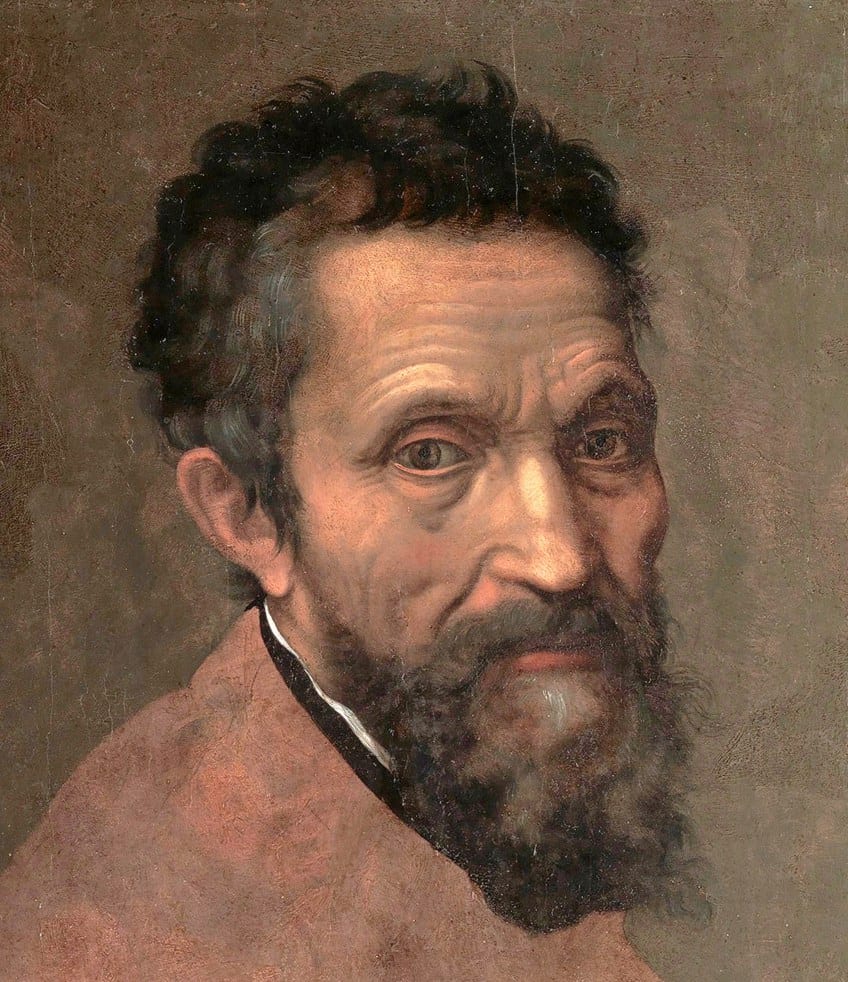
The Creation of Adam (c. 1511 – 1512)
Among the many works of art credited to the renowned sculptor, the frescoes on the ceiling of the Sistine Chapel was by far his most famous painting. Even more so, the scene depicting the creation of the first man, Adam, alongside a representation of God is considered one of the main attractions of the chapel. The famous creation of man painting depicting the hands of God and Adam almost touching has been one of the most studied and discussed topics in art history. It is a staple for any art student or enthusiast who wants to learn more about the great Renaissance masters like Michelangelo.
We will provide another look at this fresco, expanding on questions such as “When was The Creation of Adam painted, and where is The Creation of Adam located?” These, and more, will be unpacked in a brief contextual analysis below. We will also examine a formal analysis of the work to review the stylistic details of the painting and its symbolism.
| Artist Name | Michelangelo di Lodovico Buonarotti Simoni (1475 – 1564) |
| Date | c. 1511 – 1512 |
| Medium | Fresco painting |
| Genre | Religious painting |
| Art Movement | High Renaissance and Early Mannerism |
| Dimensions (cm) | 280 x 570 |
| Where It Is Housed | Sistine Chapel, Vatican City, Rome, Italy |
Contextual Analysis: A Brief Socio-Historical Overview
Spanning more than 500 square meters and an astounding 300 figures, Michelangelo surpassed all expectations for his commission on the Sistine Chapel. The Sistine Chapel tells a story to anyone who enters its space, physically or virtually. It is a treasure trove of frescoes and is home to hundreds of painted figures, who are all part of a Biblical narrative occupying its walls and ceiling. Let us take a brief tour of the Sistine Chapel to understand where The Creation of Adam by Michelangelo fits in.
The Sistine Chapel, named “Cappella Sistina” in Italian, is located in the Vatican City in Rome, Italy. It forms part of the Apostolic Palace, which is recognized as the formal residence of the Pope.
Although the Apostolic Palace is where official religious and administrative practices take place concerning the Papacy, it is also a site of significant artworks and architecture and home to the Vatican Museums. The Sistine Chapel was built from 1473 to around 1480/1481 at the request of Pope Sixtus IV. Interestingly, the chapel was named after Pope Sixtus IV, with the word “Sistine” derived from the Italian word sistino and was commonly defined as “relating to Pope Sixtus”.
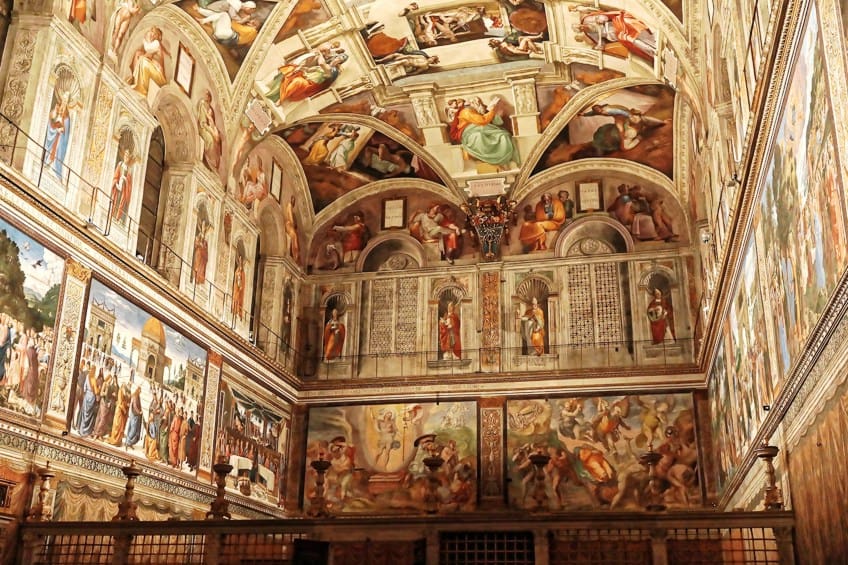
The Sistine Chapel was a renovation project aimed at rebuilding the site of the older Cappella Magna, which was already close to ruin. Many sources about the history and design of the chapel refer to two architects, namely, Giovanni de Dolci and Baccio Pontelli. Pope Sixtus IV commissioned several artists to paint the interior North and South walls; The North wall depicting the Life of Christ and the South wall depicting the Life of Moses. Among the artists were painters like Sandro Botticelli and Domenico Ghirlandaio.
Below these panels, on either side, are what is known as “trompe l’oeil” draperies, which means that they display the illusion of something real.
These walls were intended to hang real tapestries designed by Raphael, a commission made by Pope Leo X in 1515. Raphael’s tapestries depicted the lives of Saint Peter and Saint Paul, and the designs were known famously as the Raphael Cartoons. There were originally 10 designs, however, only seven remain on display at the Victoria and Albert Museum in London. Among the other important paintings on the Sistine Chapel worth exploring include the Prophet Jeremiah, The Deluge, and the Cumaean Sibyl.

In 1508, Pope Julius II commissioned Michelangelo to repaint the Sistine Chapel ceiling. The ceiling was originally painted in blue with golden dots representing the stars, created by Piermatteo D’Amelia. Reportedly, the Pope asked for a depiction of the 12 Apostles but Michelangelo proposed a more elaborate subject, which resulted in the magnificient fresco we see on the Sistine Chapel ceiling today.
According to legend, it has been speculated that the famous Italian architect Donato Bramante was deeply envious of Michelangelo’s project to build the Pope’s Tomb, and as such, convinced the pope to hire Michelangelo to decorate the chapel in a medium he knew Michelangelo was unfamiliar with.
The Sistine Chapel ceiling by Michelangelo depicts several stories from the Old Testament in the Holy Bible.
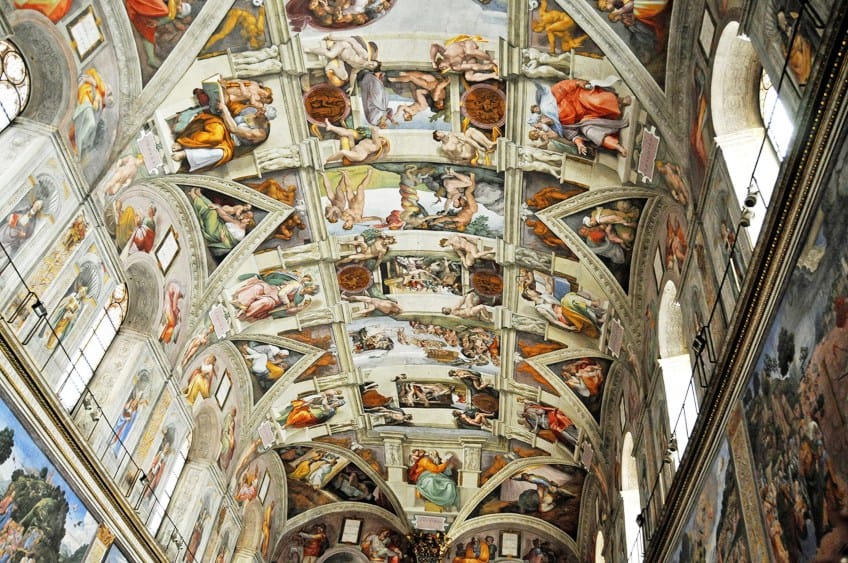
Just above the North and South walls are a series of lunettes, which depict the ancestors and forefathers of Jesus Christ. There are four large pendentives, which are triangular and positioned in each corner, depicting scenes of Israel’s salvation. Along the border of the ceiling, in line with the pendentives, one will notice smaller triangles, commonly known as spandrels.
These spandrels are believed to depict the additional family members or ancestors of Jesus Christ.
Between the spandrels and triangular pendentives are 12 figures of alternating prophets and sibyls, all carrying themes related to the arrival of Jesus Christ. The next panel consists of what is known as the central paintings, which consist of nine horizontally shaped panels grouped in threes and decorated with medallions, and male nudes called ignudi.

The central narratives were derived from the book of Genesis and are painted to be viewed from the altar on the East side of chapel. The first three scenes narrates the creation of the heavens and earth. These start with The Separation of Light from Darkness, The Creation of the Sun, Moon, and Plants, and The Separation of Land from Sea.
Here, we see the strong and powerful figure of God actively dominant in the scenes.
The next three scenes portray the iconic image of the creation of the first man, namely The Creation of Adam painting, which we will discuss in more detail below. This was followed by the Creation of Eve, The Original Sin, and Banishment from the Garden of Eden. The last three scenes depict the story of Noah, namely, The Sacrifice of Noah, The Flood, and The Drunkenness of Noah. The fresco is positioned between the Creation of Eve and the Congregation of the Waters, which makes the piece stand out tenfold.

An interesting point to note is that The Creation of Adam painting was inspired by a hymn called Veni, Creator Spiritus by Rabanus Maurus. According to a translation from the Vatican, in the hymn’s third stanza, it is written as “finger of God’s right hand” and in Latin, it translates to “dextrae Dei tu digitus”. Other translations describe it as the “finger of God’s hand”.
If we look at the essence of the description, it refers to God’s power as the creator of life.
Additionally, the art scholar Paul Barolsky wrote an article titled Michelangelo and the Spirit of God, which he published in Source: Notes in the History of Art (Volume 17, Number 4, 1998). Here, Barolsky connects the meaning of the word spiritus to “wind” or “breath”, which Michelangelo depicted in The Creation of Adam, and the source of wind spotted in the drapery and hair.
Furthermore, God is compared to the breath of creation, with his first human creation being Adam. Barolsky also mentioned that Michelangelo could have found inspiration from Sandro Botticelli’s God of wind, Zephyr in The Birth of Venus (c. 1484-1486). There are similarities between the position of Zephyr’s body and God’s body, which appears to be floating in the air as if buoyed by the wind.
A Formal Analysis of The Creation of Adam
The Creation of Adam painting is the most outstanding fresco out of the nine central panels on the Sistine Chapel ceiling. The hands of God and Adam are dramatically frozen in time, as if at any moment, the world will explode when their fingertips touch. In the formal analysis, we look further at this scene, as well as how Michelangelo created it.

Visual Description: The Subject
The Creation of Adam painting is a scene based on verse 1:27 from the book of Genesis in the Bible. As the title suggests, it portrays moment when God reaches out to touch Adam, creating him in his image. As per the New King James Version, which describes the scene as: “So God created man in his own image; in the image of God, he created him; male and female, he created them”. In the fresco, we see two large male figures. God is depicted with a long beard to the right and Adam is positioned on the left. Both figures have their arms outstretched towards one another with Adam’s left arm reaching out to God’s right arm, and both of their index fingers meeting in the center of the composition.
There is a small gap between Adam and God’s fingers, which depicts the moment before God touches Adam. This frozen moment alludes to the spark of life and the birth of the first man, who would give life to the rest of mankind.

There are many other visual differences between the two figures. Upon close inspection, one can spot God dressed in an off-white tunic with older facial features, such as a long beard, to suggest that he is older and wiser than Adam. His body was also rendered with great detail to his muscular stature, which appears firm.
There are also 12 additional nude figures in the background of the duo who appear to represent angels but have no wings. God’s left arm is seen holding another figure, who appears to be female and has been the subject of debate by many scholars.
Others believe that this mysterious figure is, in fact, a male, while some suggest that this was perhaps a representation of Eve or the Virgin Mary.
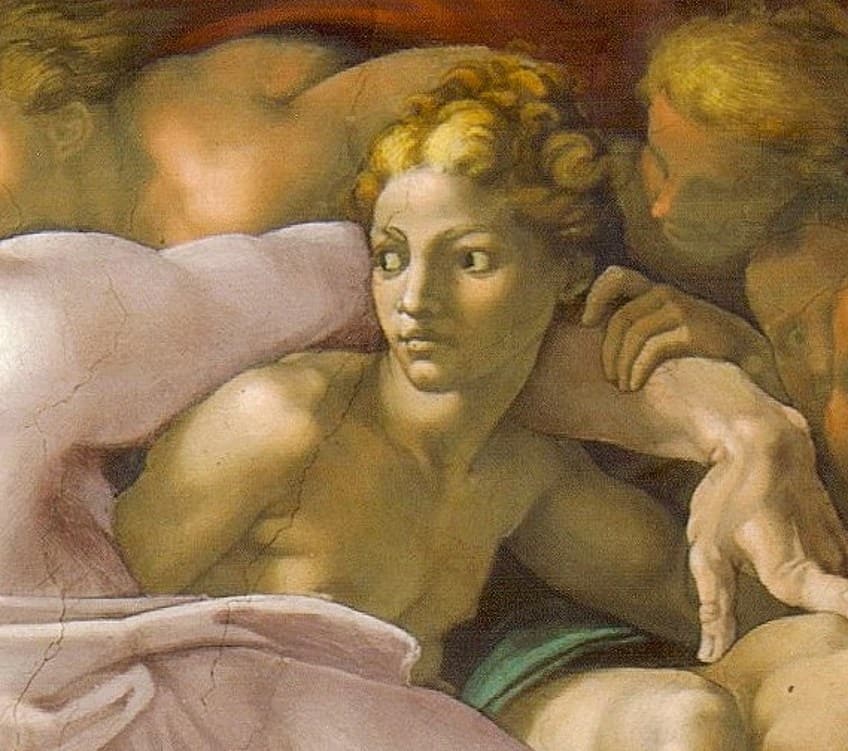
Furthermore, God’s left index finger and thumb are slightly touching the right shoulder of the infantile figure, who appears beside the mysterious figure. The infant appears to be holding onto the leg of the unidentified figure.
The rest of the figures are all depicted in varying positions as if floating in space around God and observing the spark of life.
Additionally, all the figures in the fresco are semi-enclosed by a reddish cloak behind them, while the figures at the bottom dangle outside the red cloak. A light green cloth gently billows in the same direction at the bottom of the composition and appears to be attached to the unidentified figure on God’s left side.

From this perspective, the figure of God is placed at a diagonal angle and he does not appear to be leaning on anything. You may also speculate that he was perhaps held aloft by the figures around him, however, this will be explored further below for clarification.
If we turn our gaze to Adam, we will notice he is in a reclining pose on what appears to be a grassy hillside.
There is also a blue-gray formation silhouetting the green hillside, which could possibly be a rocky formation or sky. Adam is fully nude compared to God and was also depicted with a muscular figure. He does not have a beard and is visibly younger.
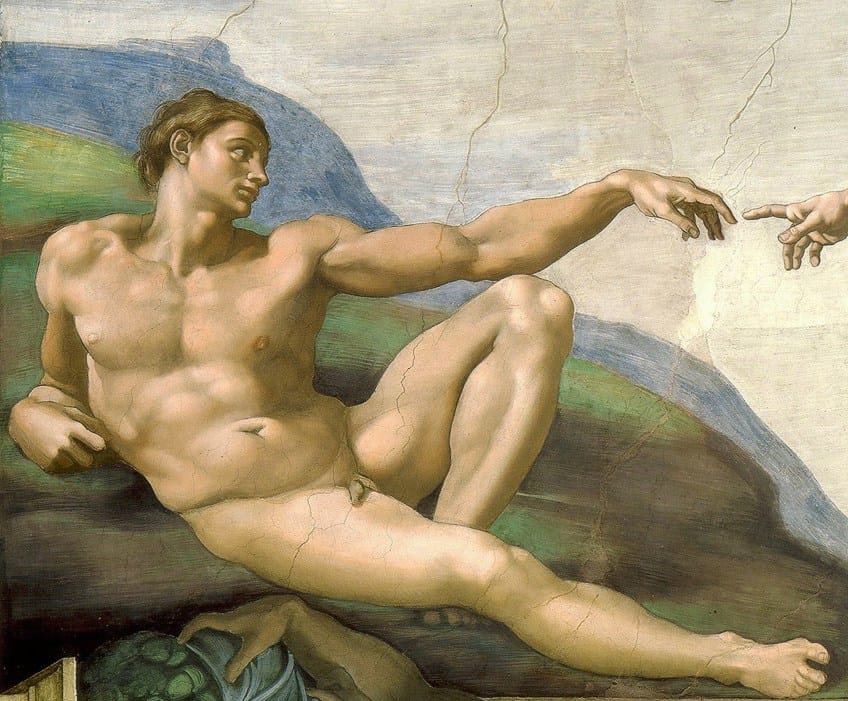
Adam appears to lean on his right elbow while his left elbow rests on his left knee, which is propped up. His right leg is outstretched on the grass in front of him and his head is slightly tilted to his left to align with the direction of his left arm, which follows his gaze towards God.
Adam’s posture has been described as more passive compared to God’s, which is fitting for his role as the receptacle of life in this narrative; Adam awaits God’s touch to give him the human life force.
Furthermore, God is looking at Adam as he stretches out towards him, dynamic in his countenance. His figure is similarly actively engaging as he reaches to Adam. Adam is also situated slightly below God, but their figures appear almost equidistant from one another.

Reviewing the Color and Value in The Creation of Adam
The Creation of Adam by Michelangelo is a fresco painting, which means that Michelangelo painted directly onto wet plaster. The color scheme appears light with a large area composed of fleshy tones such as browns and creamy colors, as well as yellows for some of the figures’ hair. God’s hair is painted in a cool gray-blue hue, which is in contrast to Adam’s hair, which appears to be a darker brown with a few light highlights.
There are also darker areas of shading on the figures, which emphasizes their shapes and anatomy, creating a sense of depth.
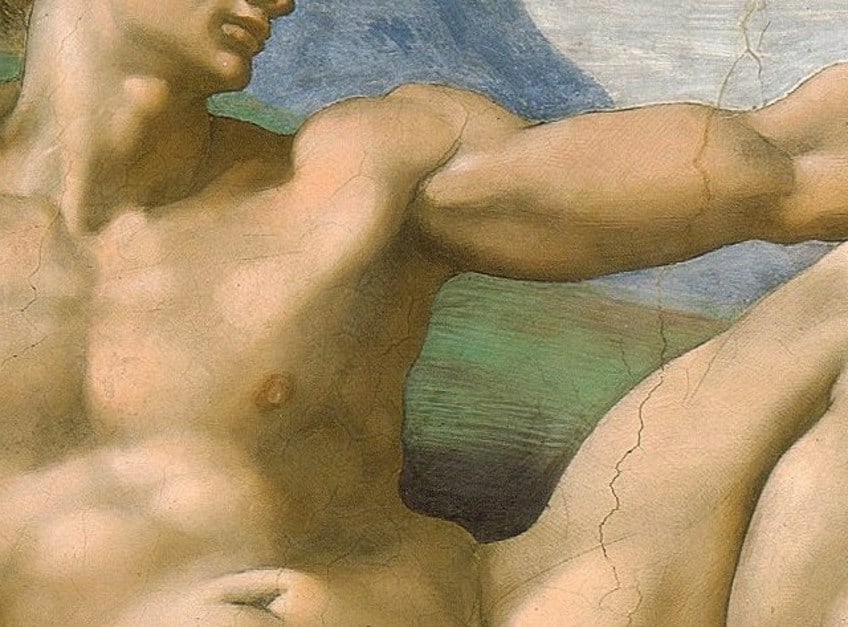
Other colors that stand out but are not overpowering include the green shades from the grass to the left, the scarf on the right, and the blue-gray hues from the rocky formation or sky behind Adam. We also see a deeper shade of red from the cloth behind God, which is a warmer color. The red hue of the cloth behind God is also said to represent a uterine mantle, which gives birth to Adam.
In Christianity, the creation of man is one of the most important episodes in Genesis, which is followed by other themes such as the fall of man from God’s grace and representations of humanity. God’s creation of Adam also demonstrates the bond of creation between God and humans and the deep relationship shared with his creations.
There is an overall harmony of color in this composition because of the similar skin tones throughout the figures in the composition.
The backdrop of green, blue, and red creates a contrasting effect and a different color value compared to the lighter value of the figures. The rest of the background of the fresco is a neutral white-gray color, which further highlights the two primary figures of God and Adam in the foreground. This background could also denote white clouds and the sky.

Exploring Textures in The Creation of Adam
One can closely observe the implied texture for the drapery and clothing, which appear light and diaphanous in texture. Furthermore, the figures are all painted with smooth skin textures, while some have more plump flesh and others are painted with muscularly taught flesh.
The figures’ hair also appears soft and flowing, notably God’s hair, which is billowing to the right of the composition from what seems to be an unknown source of wind.

Line, Form, and Shape in The Creation of Adam
There is a compositional balance created in God and Adam’s positioning. Their placements divide the composition in two parts with Adam’s overall shape described as “concave” and God’s shape, as “convex”.
This forms a perfect contrast between the two figures and hints at the deeper meaning and relationship between God and Adam.
Furthermore, the backdrops behind each figure are dominantly curved shapes, which are contrasted by the strong horizontal line created from the outstretched arms and culminating hands of God and Adam, which seemingly connect the two parts mentioned above.

Science and Symbolism in The Creation of Adam
The artworks by Michelangelo, who painted The Creation of Adam, have been widely studied topics by many art historians and scholars, including those in the field of science. There have been a wide variety of theories proposed around what Michelangelo meant in his fresco of God touching Adam, or the imminent moment before he touches him. Below, we will mention some of the common theories, however, we encourage you to delve deeper into additional meanings and mysteries surrounding this famous painting.
Michelangelo was truly a skillful artist but he was also an intelligent man, who undoubtedly understood more than most in the age he lived.
Some of the more popular theories include the hypothesis of Frank Lynn Meshberger M.D., who posited that the form we see behind the figure of God and the 12 angelic figures resemble the anatomical structure of the human brain. Furthermore, various placements like the figure that appears “sad” to God’s left and God himself, correspond to functions of the brain.
For example, Meshberger explained in his publication An Interpretation of Michelangelo’s Creation of Adam Based on Neuroanatomy (1990), that the figure of God is “superimposed” over what is known as the limbic system of the brain, which is responsible for emotions. The above-mentioned “sad” figure next to God is placed in an area of the brain where the emotion of sadness has been detected on PET (Positron Emission Tomography) scans. How incredible?
Additionally, if we look at the outstretched hands of God and Adam, God’s arm is reportedly positioned in the same spot of the brain known as the prefrontal cortex, which is known for stimulating creative thinking processes.
Meshberger also drew a connection between the “intellect” and the “divine part” from one of Michelangelo’s sonnets, where the artist explained that the “ready hand” can start “only after the intellect has planned”. In other words, here, the intellect is considered as the “divine part”. As Meshberger explained, Michelangelo had the awareness that his skills originated from “his brain and not his hands”. Thus, even scientists have analyzed this incredible artwork to conclude that it exists as a symbol of the birth of humankind.
Other theories point to the idea that Michelangelo painted God in a red womb and the green scarf could be the divine umbilical cord, from which Adam had detached. This is understood as symbolic of the birthing process and that Adam was newly created, or birthed, by God.
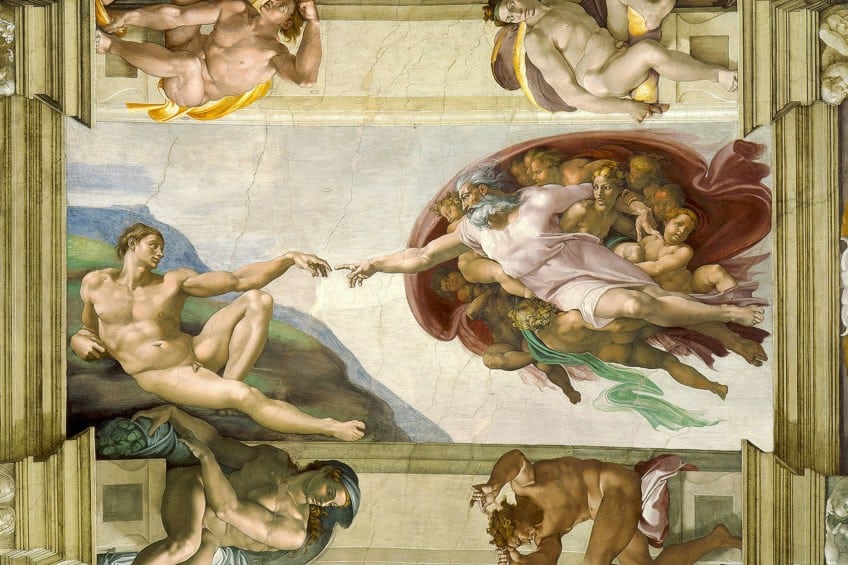
Pointing Fingers at Michelangelo’s Masterpiece
The hands of God and Adam have been immortalized and appropriated in contemporary culture, forever emblazoned as a contemporary pop-cultural symbol in films, television series, and video games. Other examples include the famous promotional poster for the 1982 movie E.T. by Steven Spielberg and parodies by artists and designers, including James Hance’s The Creation of Muppet and Arne Niklas Jansson’s Touched by His Noodly Appendage (2005).
Michelangelo’s God-touching-Adam fresco on the ceiling of the Sistine Chapel is hands down one of the most endearing renderings of a biblical scene from the late Renaissance era. Not only is it admired for its beauty but it is also praised for its inherent mystery that appears straightforward in its visual portrayal, but holds a wealth of meaning beyond what the eye sees.
Take a look at our Creation of Adam webstory here!
Frequently Asked Questions
Who Painted The Creation of Adam?
The Creation of Adam (c. 1511-1512) was painted by Michelangelo Buonarotti and is part of the ceiling of the Sistine Chapel. The painting depicts the scene of the hands of God in a close encounter with the hands of Adam, which signifies the creation of the first man. Michelangelo was one of the greatest artists from the Renaissance era, as well as one of the forerunners of the early Mannerism art style that developed after the High Renaissance.
When Was The Creation of Adam Painted?
The Creation of Adam by Michelangelo Buonarotti was painted between 1511 and 1512, which was during the time when the Renaissance artist painted the Sistine Chapel ceiling, which he started around 1508 and finished in 1512.
Where Is The Creation of Adam Located?
The Creation of Adam (c. 1511-1512) by Michelangelo is a fresco painting that forms part of a series of frescoes on the ceiling of the Sistine Chapel. The painting is located in the Vatican City in Rome, Italy.
Alicia du Plessis is a multidisciplinary writer. She completed her Bachelor of Arts degree, majoring in Art History and Classical Civilization, as well as two Honors, namely, in Art History and Education and Development, at the University of KwaZulu-Natal, South Africa. For her main Honors project in Art History, she explored perceptions of the San Bushmen’s identity and the concept of the “Other”. She has also looked at the use of photography in art and how it has been used to portray people’s lives.
Alicia’s other areas of interest in Art History include the process of writing about Art History and how to analyze paintings. Some of her favorite art movements include Impressionism and German Expressionism. She is yet to complete her Masters in Art History (she would like to do this abroad in Europe) having given it some time to first develop more professional experience with the interest to one day lecture it too.
Alicia has been working for artincontext.com since 2021 as an author and art history expert. She has specialized in painting analysis and is covering most of our painting analysis.
Learn more about Alicia du Plessis and the Art in Context Team.
Cite this Article
Alicia, du Plessis, ““The Creation of Adam” by Michelangelo – An In-Depth Analysis.” Art in Context. June 21, 2022. URL: https://artincontext.org/the-creation-of-adam-by-michelangelo/
du Plessis, A. (2022, 21 June). “The Creation of Adam” by Michelangelo – An In-Depth Analysis. Art in Context. https://artincontext.org/the-creation-of-adam-by-michelangelo/
du Plessis, Alicia. ““The Creation of Adam” by Michelangelo – An In-Depth Analysis.” Art in Context, June 21, 2022. https://artincontext.org/the-creation-of-adam-by-michelangelo/.



